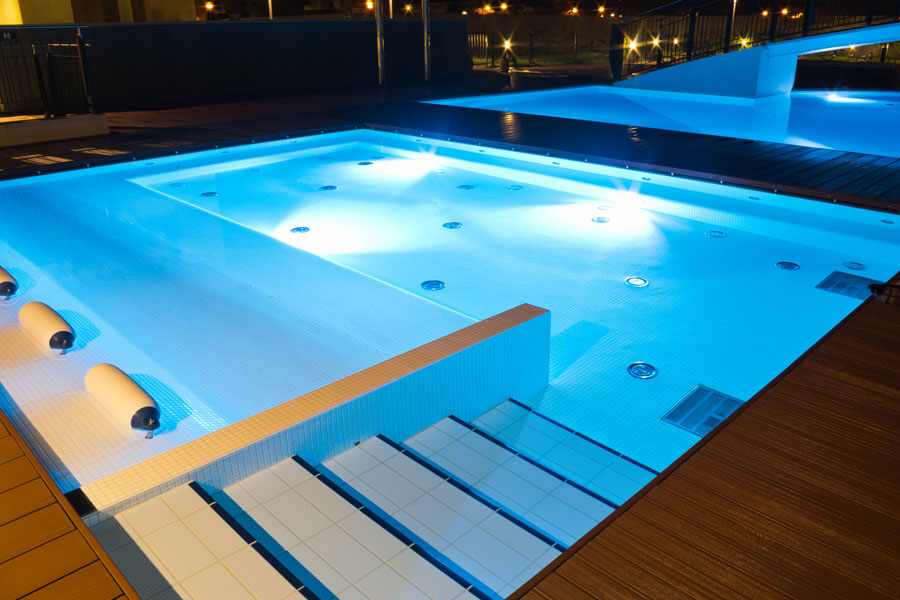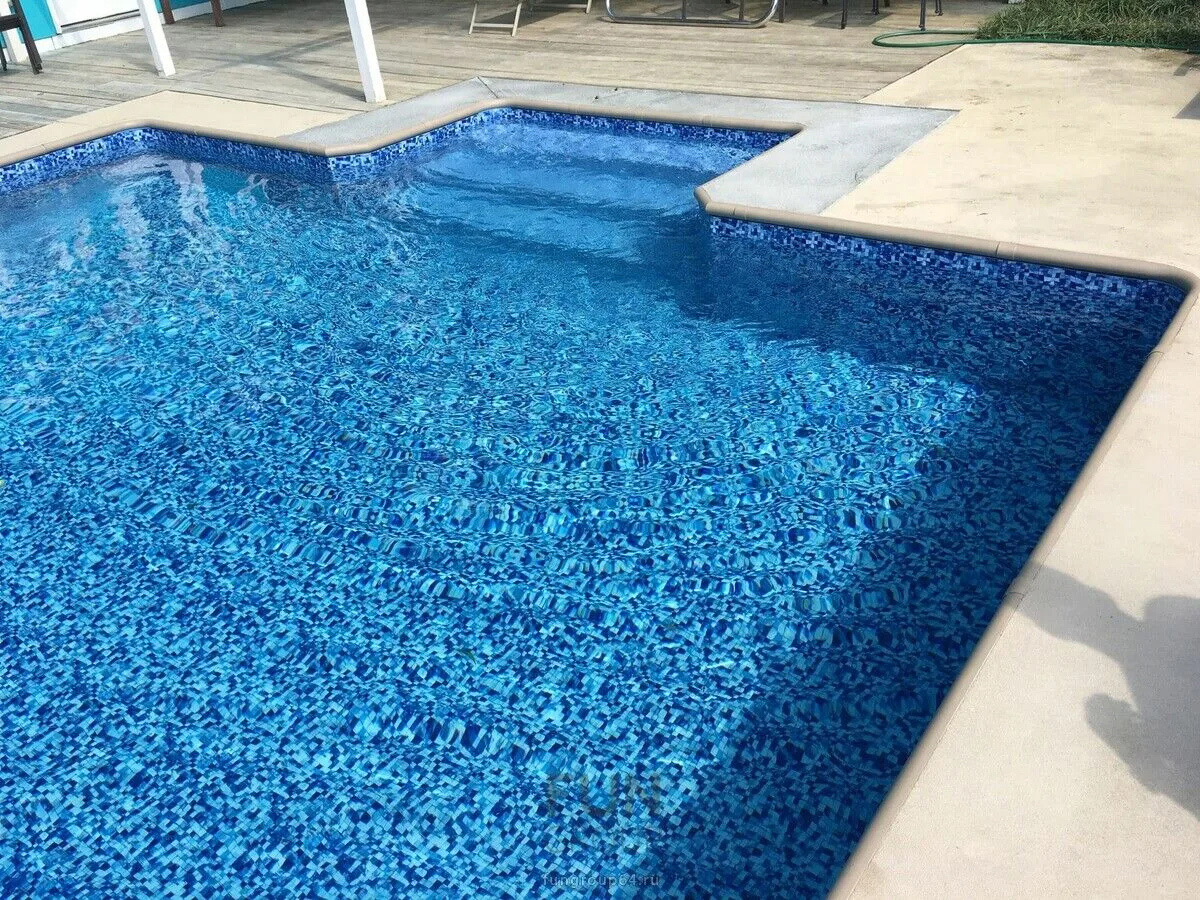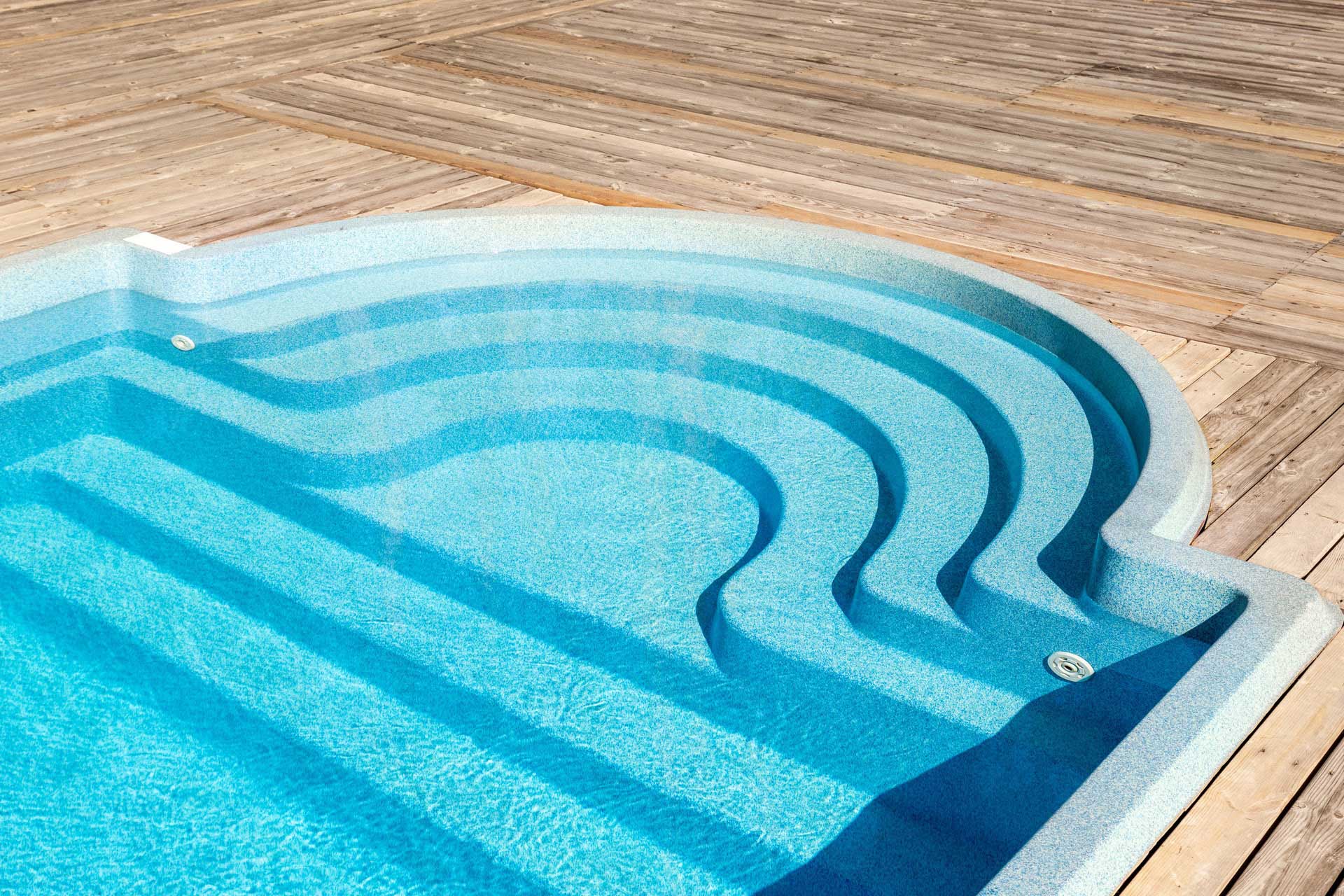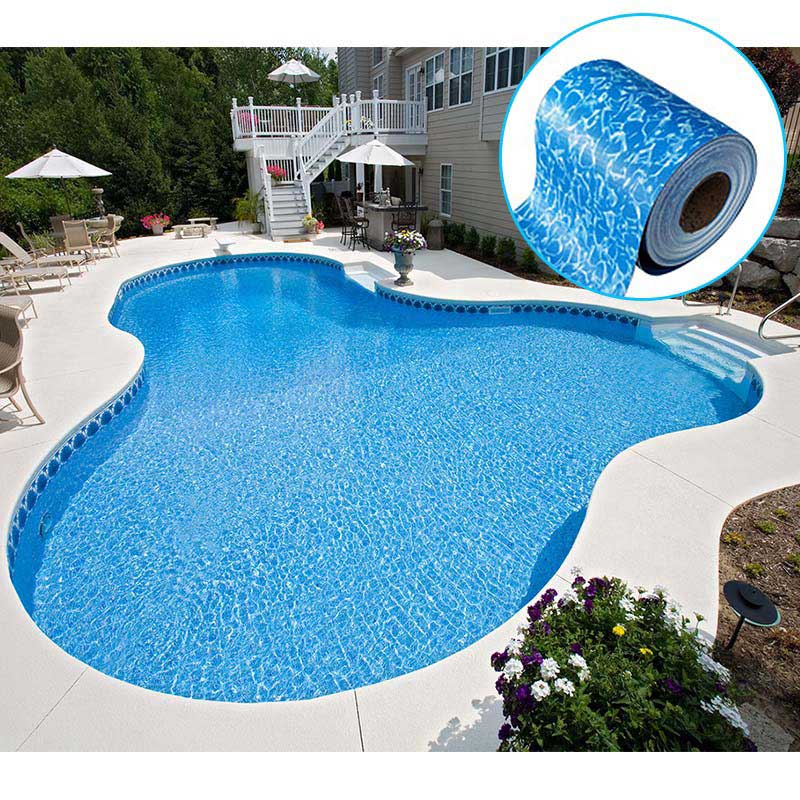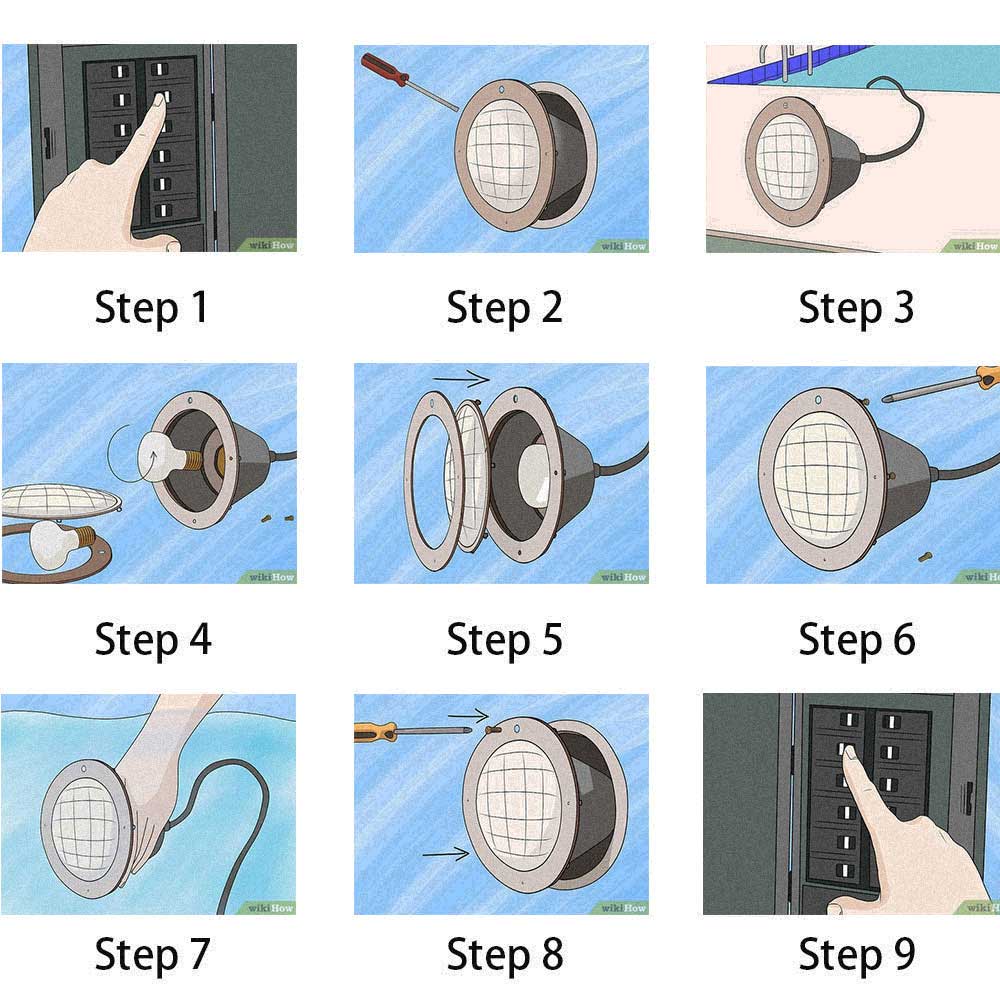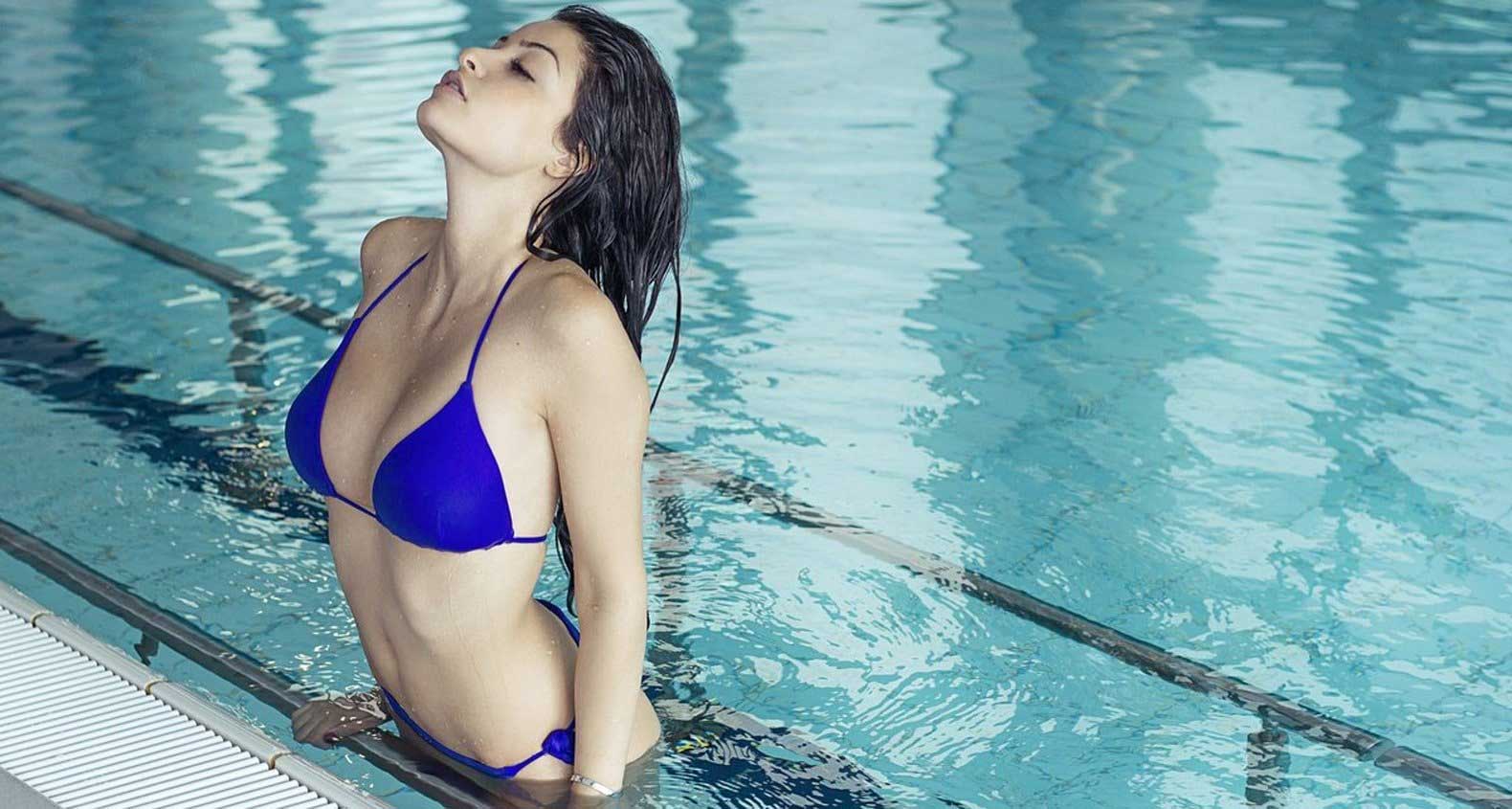LED POOL LIGHTS
What is led pool light?
LED Pool lights are lighting equipment specifically used for swimming pools,Which mainly used to provide lighting and decorative functions.According to the installation method,There are major kinds of pool lights, including wall surface mounted lights,recessed pool lights,hanging pool lights,and floating pool lights.
Types and features of led pool lights
1.Wall mounted lights: installed on the surface of pool wall, the light body is flush with the inner wall of the pool, and does not affect the overall beauty of the pool.At night, the light from the pool lights is soft, which will not be dazzling and will not affect the water quality.
2.Embedded pool lights: installed inside the pool wall, the light body is flush with the inner wall of the pool, suitable for home pools and hotel pools.
3.Suspended pool lights: simple installation, no need to damage the inner wall of the pool, suitable for later installation or replacement, especially suitable for temporary pools and portable pools.
4.Floating pool lights: floating on the water, easy to use, the light position can be adjusted at any time, mainly used for decoration and creating atmosphere, such as pool parties and night activities.
5.LED strip lights: flexibly installed on the edge of the pool, providing a continuous light source effect, suitable for commercial pools and landscape pools.
Application scenarios of swimming pool lights
- Home swimming pools: provide safe lighting and increase the fun of swimming at night
- Hotel swimming pools: enhance the overall visual effect and provide guests with a safe swimming environment.
- Temporary swimming pools and portable swimming pools: easy to install, provide sufficient lighting and safety.
- Commercial swimming pools and landscape swimming pools: create a broad and bright visual effect.
*
* How to choose Led Pool Light for pool?
Swimming pools have become an integral part of modern leisure and entertainment facilities. Whether it is a public facility, a hotel or a private residence, a well-designed swimming pool not only provides a place for exercise, but also an ideal space for people to relax. As a key component of the swimming pool lighting system, pool lights not only provide safety for nighttime use, but also add a charming glow to the swimming pool.
Led Pool lights are divided into the following categories according to the installation method
Recessed pool lights
Recessed pool lights are a more common type, which requires the installation location of the lamp to be planned in advance when the swimming pool is built, and the corresponding holes are reserved. Once installed, this type of lamp will blend into the pool wall, which is both beautiful and does not affect the fluidity of the water body. The design of the recessed lamp takes into account waterproof performance, and usually uses high-strength sealing materials to ensure safety under long-term use.
Wall-mounted pool lights
For those who want to add lighting facilities to existing swimming pools, wall-mounted pool lights are an ideal choice. They can be installed directly to the side wall of the pool and can be quickly installed with simple fixings. This type of lamp is suitable for swimming pools of various materials, including but not limited to civil engineering, fiberglass, film and steel structure swimming pools. It is highly flexible and easy to maintain.
Casing pipe pool lights
The sleeve-type underwater lights adopt a unique installation method, that is, first put the waterproof rubber ring and embedded parts into the pool wall hole, then insert the sleeve and the lamp body in turn, and finally fix it from the outside of the pool. This method ensures the stability and waterproofness of the lamp and is suitable for all types of swimming pools.
Par56 Pool light Replacement source
With the development of technology, a variety of replacement light sources have appeared on the market, such as standard sizes such as PAR56, PAR38, PAR30 and E27, which can easily replace aging or damaged bulbs. These light sources are compatible with international standard accessories, making maintenance more convenient.
Concrete pool underwater lights
For sturdy and durable concrete structure swimming pools, civil engineering pool underwater lights came into being. Considering the thick walls of civil engineering swimming pools, these lamps are usually equipped with additional wall tubes to assist the installation process. This not only enhances the stability of the lamps, but also ensures good waterproofing.
Fiberglass pool underwater light
Fiberglass swimming pools are favored by many users because of their light weight and corrosion resistance. The specially designed fiberglass pool underwater lights have threaded interfaces and matching waterproof components, such as rubber rings, gaskets and nuts, to meet the installation needs of this special material.
Lined pool or PVC pool underwater light
PVC pool (also called a liner pool or PVC pool) is characterized by the use of a layer of waterproof PVC or other synthetic material as a waterproof barrier inside the pool. This type of pool is popular with many people because of its easy installation, low cost and relatively simple maintenance.
In short, choosing a suitable swimming pool light should not only consider whether its appearance design meets the requirements of the overall environment, but more importantly, pay attention to the safety and reliability of the lamp. Professional installation services should also not be ignored. Correct installation can extend the service life of the lamp and ensure the safety of the user. Therefore, when purchasing and installing led swimming pool lights underwater, please be sure to consult professionals to ensure that every detail is perfect.
* How many LED lights should I put in my pool?
Usually, rectangular swimming pools are symmetrically installed on both sides, with each pool light spaced approximately 3 meters apart. Circular or irregular swimming pools can be installed in a dispersed manner along the edge. For small household swimming pools (such as 6×4 meters), usually 4 to 6 cups are sufficient. For large swimming pools, the number can be increased according to the actual situation. If you have more design requirements, you can consult professionals.
* How to replace the pool lights underwater?
If many swimming pools are equipped with LED underwater lights, on the one hand, they can provide lighting, making the swimming pool no longer dark at night and enhancing safety; on the other hand, they can also decorate the pool and become a unique scenic feature. However, just like other types of lamps in other locations, underwater lights may burn out or malfunction. So, how should we replace or repair them? Do we need to drain the water from the pool? Here, we will teach you how to replace the underwater lights!
- First, locate the distribution box that connects all the underwater lights, cut off all the power supplies, press the switch of the lamps, and check if the power has been completely cut off.
- It would be best to prepare two screwdrivers, either Phillips or flat-head ones, and unscrew the top screws on the lamp.For some models of underwater lights, there will be a snap at the bottom. By grasping the snap, you can loosen the lamp.
- Remove the pool lights from the hanging fixtures/pre-installed parts. Generally speaking, when installing LED underwater lights, 1-2 meters of electrical cable is usually reserved. Therefore, we don’t need to drain the water from the swimming pool. Just pull the underwater lights to the pool shore directly.
- Remove the screws from the lampshade or pry open the lampshade.For some older pool lights, you must first unscrew the screws before removing the lampshade. Most new pool lights have snap-on covers, and you can remove the lampshade by simply prying open the snap-on cover.
- Temporarily connect the power supply, and test if the bulb is lighting up.
- Light the bulb for a short while to confirm that the pool light is working properly. Then, cut off the power supply and reinstall the pool light in its original position to complete the replacement.
*
* Pool light selection: AC or DC?
Differences Between AC and DC
Alternating Current (AC)
Direct Current (DC)
Differences Between AC and DC for Color-Changing RGB LED Pool Lights
AC LED Pool Lights
DC LED Pool Lights
- DC swimming pool LED light (low-voltage DC light)
This is the absolute mainstream and recommended choice for both new swimming pool installations and renovation of old pools.
Working principle: Install a transformer in the swimming pool equipment area to convert the household 220V (or 120V) alternating current into safe 12V or 24V direct current, and then supply it to the lights in the swimming pool.
Advantages:
Safety first: Low voltage means that even if there is an electric leakage in water, it will not cause a serious electric shock accident. This is its most crucial advantage.
Energy conservation and environmental protection: LED lights are extremely energy-efficient and can save a significant amount of electricity over time.
Colorful: You can freely customize the atmosphere of the swimming pool, ranging from the serene blue to the passionate red, or use the colorful dynamic mode for parties.
Long-lasting and durable: The lifespan of LED is very long, and it can basically be maintained without maintenance for many years.
Disadvantages:
Initial cost is high: The price of the lamp itself and the transformer is higher than that of traditional AC lamps.
Required transformer: The transformer is another component that needs to be installed and occasionally maintained (though it is usually very reliable).
- AC swimming LED Pool Light (high-voltage alternating current light)
This was the traditional technology in the past, but it has gradually been phased out now.
Working principle: It is directly connected to the 220V (or 120V) AC circuit in the home. It must be connected to a leakage protection device (GFCI) by a professional electrician, so that it can trip instantly when a minor leakage is detected, providing crucial safety protection.
Advantages:
Initial price is low: The structure of the lamp is simple and the purchase cost is relatively low.
No need for a transformer: The system is simpler.
Disadvantages:
Safety Risk: Although protected by GFCI, the high voltage electricity directly reaching the pool area remains a potential hazard. The GFCI may also fail due to aging, damage, or lack of regular testing.
Single function: Usually can only emit one type of light (traditional white yellow light).
High energy consumption: It’s like a small electric stove, consuming a lot of electricity.
High maintenance: The bulbs need to be replaced frequently. Each replacement requires draining the water above the pool level or conducting underwater operations by divers, which is troublesome and costly.
——–
MAYHAN is a professional LED underwater pool light manufacturer. We produce a variety of AC and DC LED pool lights. If you’re interested in our products or have any questions about these two types of pool lights, please feel free to contact us.
Pool lights, especially LED lights, can typically last for many years, with a lifespan usually ranging from 7 to 15 years, or even longer. In contrast, incandescent and halogen lights have shorter lifespans, typically requiring replacement every few years.
1.Here is a detailed breakdown by type of light:
-
LED pool lights:
LED lights are the most durable and energy-efficient option, with a lifespan of up to 25,000 to 50,000 hours or more. This means they can be used for approximately 7 to 15 years, or even longer with proper maintenance and usage patterns.
-
Incandescent pool lights:
These lights have the poorest durability and energy efficiency. They typically last only 1,000 to 5,000 hours, approximately 1 to 3 years.
-
Halogen pool lights:
Halogen lights fall somewhere between incandescent and LED. Their lifespan is approximately 4,000 to 8,000 hours, approximately 2 to 4 years.
2.Factors affecting lifespan:
-
Usage frequency: The higher the usage frequency, the shorter the lifespan.
-
Quality: High-quality LED pool lights from well-known manufacturers typically have a longer lifespan, such as the HOTOOK brand. This brand is based on the concept of high-quality products, and its LED pool lights are usually produced using high-quality 316 stainless steel and PC materials.
-
Maintenance: Regularly operating the light bulbs (at least once a week) and ensuring the lamp is well-sealed can extend their lifespan.
-
Environmental factors: Exposure to various natural environments (such as water and temperature changes) can affect the lifespan.

